We know it’s not easy to succeed in today’s market as a small or medium-sized business (SMB).
- New competitors pop up all the time.
- Rapid technology changes make it hard to keep up.
- Today’s tech-savvy customers want more seamless and convenient experiences with brands.
Some of these factors are outside of your control, so it’s important to focus on the critical components of your business you can influence and change—such as sales productivity!
Why focus on sales productivity?
The productivity and effectiveness of your sales teams directly impacts your bottom line.
That means that maximizing the productivity of every sales representative can be the difference between your business meeting financial goals or falling short. More productive sales reps also have more time to spend engaging with potential customers, building relationships, and closing more sales.
How can you improve sales productivity?
The first step to creating a productivity improvement strategy is to research what strategies are working, which ones aren’t, and what sales professionals experience daily.
We’ve done some research on your behalf to find the sales productivity statistics you need to know to help inform and evolve your strategy. Read on to begin learning.
What It’s Like for Today’s Sales Professionals
Unproductive. Repetitive. Inefficient.
Ask any salesperson to describe their average workweek, and you’re likely to get an answer with at least one of those three words.
Don’t just take our word for it, check out what the latest research tells us about what an average day is like for sales professionals.
- Salesforce reports that sales reps spend only 30% of their time selling during an average week. (Source: Salesforce, State of Sales Report Sixth Edition, 2024)
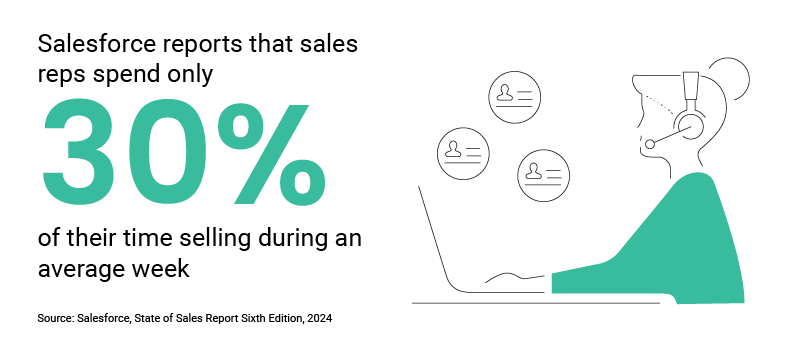
- Even worse, HubSpot research suggests sales reps spend only 2 hours per day selling. (Source: HubSpot, 2024 Sales Trends Report)
If there is so little time left to sell each week, what else takes up sales professionals’ time?
- 68% say note taking and data input are their most time-consuming tasks. In fact, 43% report that administrative work occupies between 10 and 20 hours each week. That’s almost half a workweek! (Source: Salesroom, The State of B2B Sales Performance: Challenges, Strategies, and the Key to Success, 2024)
However, there may be an upside to spending a good chunk of time doing some administrative or prep work.
- LinkedIn reports that top-performing salespeople spend about 18% more time updating their CRM system than average salespeople. (Source: LinkedIn, LinkedIn State of Sales Report 2022
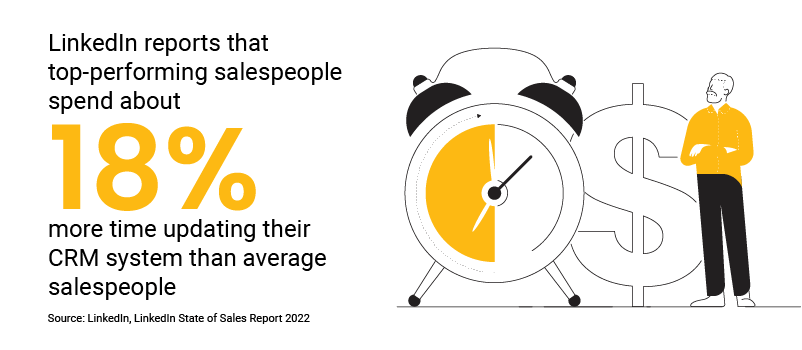
Furthermore, time spent researching prospects instead of selling may pay off.
- 82% of top performing salespeople say they always perform research before contacting prospects, compared to 49% for other sellers. (Source: LinkedIn, LinkedIn State of Sales Report 2022)
- And 42% of B2B sales pros say the most effective way to make the sale is by researching a prospect’s company and figuring out its challenges and opportunities. (Source: HubSpot, 94 Key Sales Statistics to Help You Sell Smarter in 2024)
So, if top-performing salespeople do prep and administrative work, how can sales leaders encourage all team members to do it without taking up most of their workweek? Technology.
Boosting Sales Productivity with Technology
The use of technology in sales is nothing new. What is new is the rise of AI and other advanced technologies, and their potential to revolutionize how sales teams operate.
By adopting and integrating innovations like AI-driven automation, advanced customer analytics, and generative AI, businesses may benefit from increased sales productivity, improved lead targeting, higher customer engagement, and, revenue growth.
Let’s explore more about the use of tech in sales by first hearing from the people it affects most—sales professionals and leaders!
- 29% of sales pros say that reducing their tech stack would make them more efficient. (Source: HubSpot, 2024 Sales Trends Report, 2024)
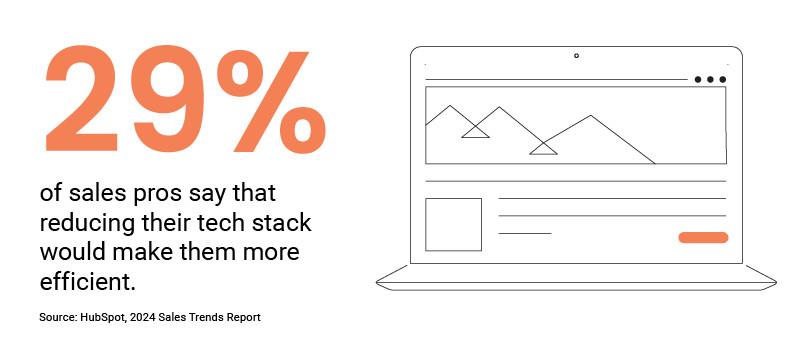
- Some sales leaders agree, with 1 in 4 sales leaders stating they have too many sales tools in their tech stack. (Source: HubSpot, 94 Key Sales Statistics to Help You Sell Smarter in 2024)
- However, the technology teams are warming up to is AI. 81% of sales leaders think AI can help reduce time spent on manual tasks. And in a Salesforce survey, 84% of salespeople who currently use AI say it helped boost sales by improving and accelerating customer interactions. (Source: 2024 Sales Trends Report and Salesforce, Top Generative AI Statistics for 2024)
The jury may still be out on using technology to improve sales productivity from the sales team perspective. However, the research presents a clearer picture of the productivity benefits to be gained from using technology in sales.
- High-performing sales teams use nearly 3X the amount of sales technology than underperforming teams. (Source: Salesforce, Third Edition State of Sales report)
- According to the Sales Management Association, organizations that effectively use sales technology were 57% more efficient at sales development and training than ineffective technology users. (Source: Sales Management Association)
The research shows when used correctly and effectively, technology can be a boost for sales productivity and performance. Let’s dive into what type of technology is most useful for productivity.
Automation and AI
- Automation and AI can free up about 20% of a sales team’s capacity. (Source: How Top Performers Outpace Peers In Sales Productivity, 2023)
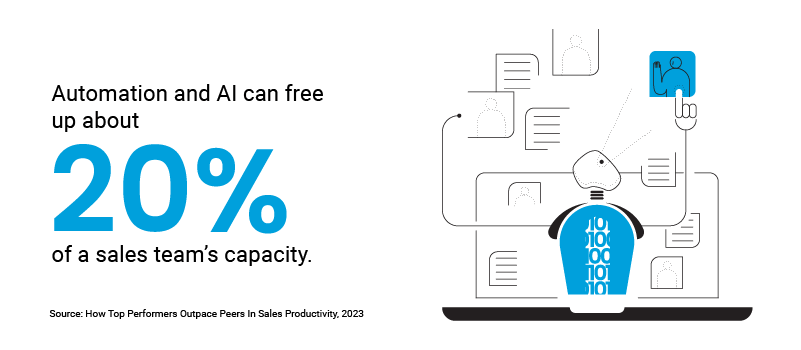
- Marketing automation drives a 14.5% increase in sales productivity and a 12.2% reduction in marketing overhead overall, according to Nucleus Research. (Source: Marketing Drives CRM ROI, 2021)
- 47% of companies say that AI tools have improved lead generation. (Source: Lightspeed, 2023 GTM & Sales Benchmark Report)
- High-performing companies are 2X as likely as underperforming companies to describe their sales processes as automated. (Source: Velocify, New Study Reveals What Separates Average Sales Organizations from Great Ones)
CRMs
- Data accessibility enabled by CRMs can help shorten sale cycles by 8-14%. (Source: Nucleus Research)
Phone
- Marc Wayshak, an expert and sales strategist, found out in a survey he conducted that 2% of salespeople responded that the phone remains the most effective and efficient sales tool. (Source: Sales Insights Lab, 23 Surprising New Sales Statistics for 2023 from Our Groundbreaking Studies!)
Sales Enablement Software
- 55% of C-suiters confirmed that sales enablement software is the top tech investment ideal for boosting sales productivity. (Source: Forbes in Association with Brainshark, The Power of Enablement: Bridging the Sales Productivity Gap)
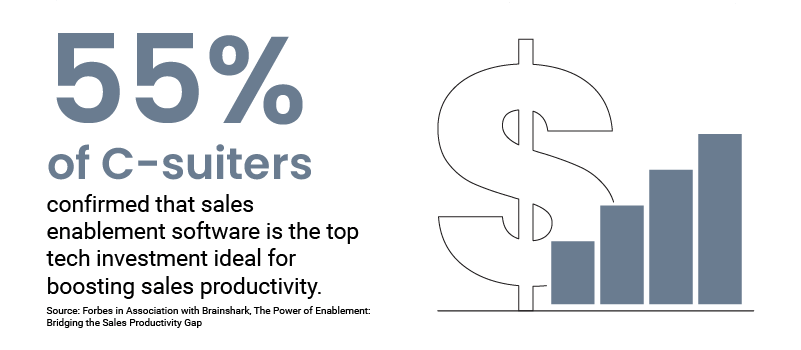
It’s clear sales teams have many technology options to choose from to help boost their productivity. The technology that’s right for your business will depend on your unique challenges, goals, and employees.
How to Improve Sales Productivity with These Statistics
Now that you have a basic understanding of some of the challenges sales professionals and leaders face and the technology options available to help them, you can start to explore these topics from your business’s perspective. Here are several steps we would recommend:
- Define what sales productivity means for your business. There are several ways you can define productivity, and you should determine what best fits your business. For example, should productivity be measured by the length of a sales cycle? What about quota attainment? Or do you value the win rate of your sales teams? Take time and think about how your business defines sales productivity.
- Find a way to measure your definition of productivity. Once you know what productivity means for your business, you can start to measure it. Some examples of productivity measurements include time spent on actual selling, close rates, lead response time, and upsell and cross-sell rates.
- Get input from your sales professionals (qualitative data). Keep an open mind and talk with your sales teams about their pain points and individual needs. Ask them what they think is working and what could be improved. See if they have specific process or technology recommendations. Let them share what helped or hindered their productivity in past workplaces. Make everyone feel heard in this initiative to help ensure acceptance and adoption of updates to processes or new technologies.
- Review the hard information available to you (quantitative data). Once you have talked with all your sales employees, review the factual, objective, and measurable data available to you. This will give you another perspective of the current state of sales productivity. Analyze this data to identify trends or gather insights that can’t be found in qualitative data.
- Combine your hard and soft data and build a productivity improvement strategy. Get a more holistic view of sales productivity to better inform your decision-making and to guide your improvement strategy creation.
- Research sales technologies, select a vendor, and implement. If updating or upgrading technology was part of the improvement strategy you created, this step will be one of your most important. This process can be complex, lengthy, and involve multiple departments in your business. You’ll want to make sure you are being thorough and diligent when researching and account for a timeline that can take months or up to a year to complete.
Final Thoughts
As your business works to get ahead and stay ahead in a hyper-competitive landscape, maximizing your sales productivity is crucial for driving growth and meeting your financial goals. As highlighted by the research and statistics throughout this blog, sales teams face numerous challenges, including time-consuming administrative tasks and inefficient use of resources. However, by focusing on proven strategies such as leveraging AI, automation, and other sales technologies, you can streamline operations, improve lead targeting, and enhance sales performance.
Ultimately, the key to improving your sales productivity is to take a balanced approach that incorporates both technology and human insight. By achieving this balance, you can empower your sales team to operate more efficiently, close more deals, and contribute to the overall success of your business in 2024 and beyond.






